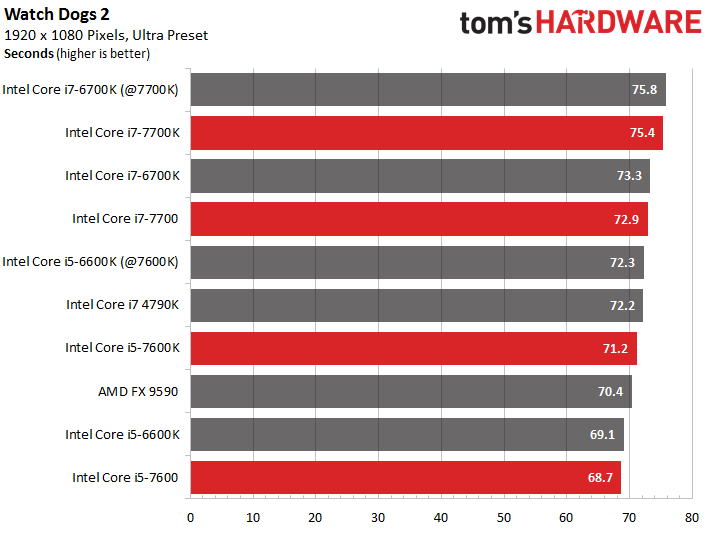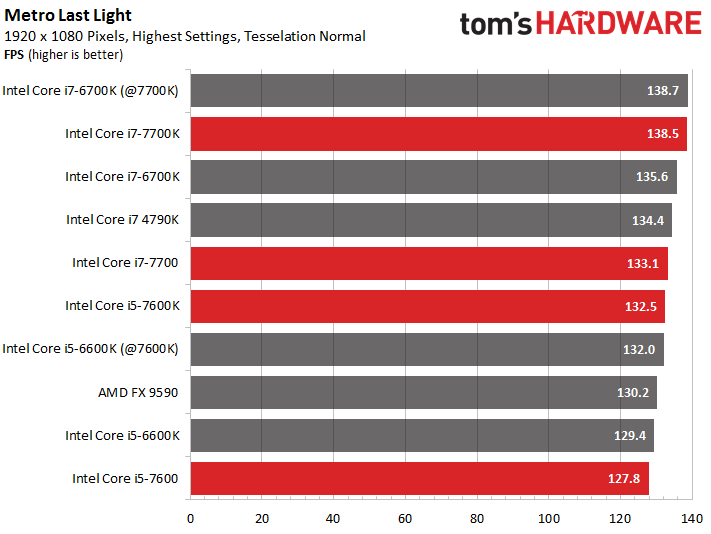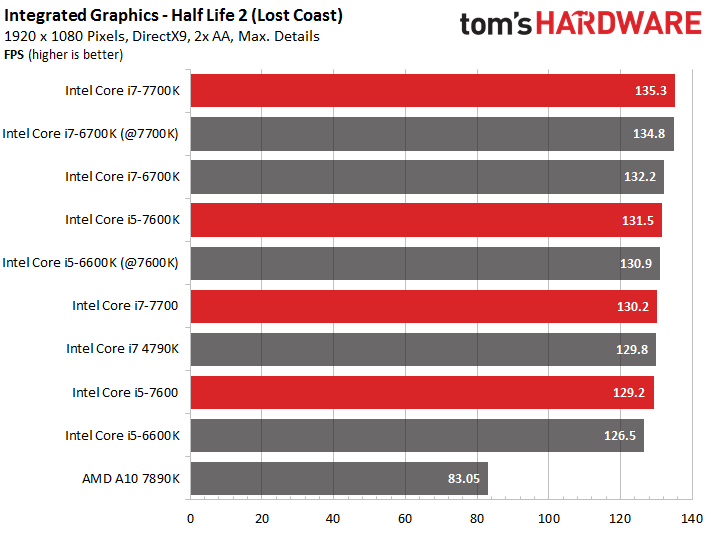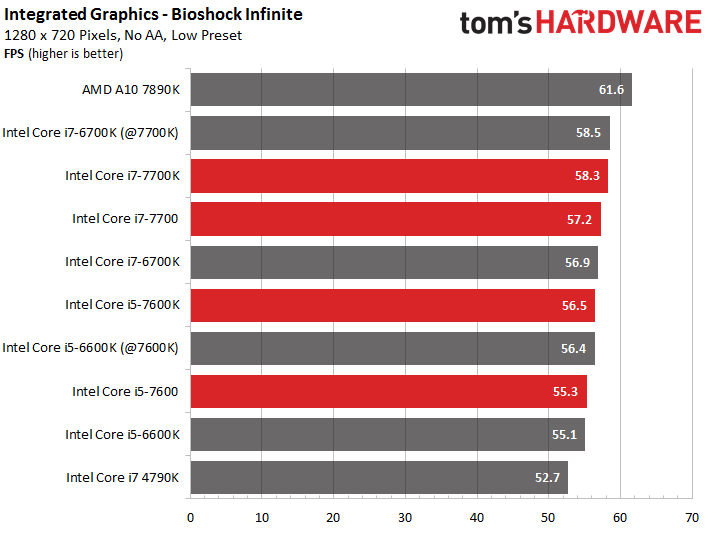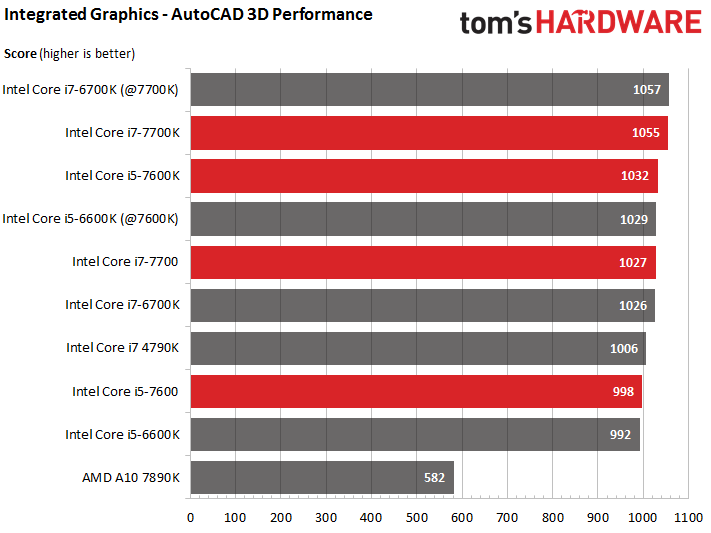Intel Kaby Lake Core i7-7700K, i7-7700, i5-7600K, i5-7600 Review
Results: Gaming And Integrated Graphics (iGP)
3D Performance with a Discrete Graphics Card
Of course, gamers want to know just how well Intel’s new Kaby Lake CPUs fare under the latest games. In the next two tests we used an Nvidia GeForce GTX 1080 Founders Edition.
Discrete Graphics: Watch Dogs 2
Watch Dogs 2 likes to have four physical cores, and continues to scale with more threads enabled via SMT. However, the game’s performance doesn’t ramp up linearly with thread count. A fast quad-core CPU without SMT is perfectly ample.
Discrete Graphics: Metro: Last Light
Metro: Last Light uses a lot of computing power for physics, especially since we disabled PhysX. We also skipped any form of anti-aliasing and SSAO to achieve the highest possible frame rate. These CPUs don't bottleneck performance, but the difference between the fastest and slowest ones are approximately 10 percent.
As we've seen already, corresponding Kaby Lake and Skylake CPUs at the same clock frequency perform the same.
3D Performance with Integrated Graphics (iGP)
Nobody’s going to play current games on integrated graphics after spending big bucks on a high-end platform. Still, we tested two titles using settings that provided playable frame rates anyway, even though Intel’s drivers don’t really deal with this kind of task very well. We also want to know if AutoCAD works with an integrated graphics solution. Since AMD’s FX-9590 is the only test CPU without integrated graphics, we used one of AMD’s APUs, the A10-7890K, instead.
Integrated Graphics (iGP): Half Life 2 - Lost Coast
Half Life 2 runs on anything, even the most entry-level GPUs. The only host processing attribute that matters is clock rate and, by extension, IPC throughput. When this game was made, nobody was thinking about four or more x86 cores. Intel’s graphics driver works fairly well in this case. Consequently, the performance of AMD’s APU takes a hit due to its lackluster CPU. The game runs on one core alone, and the graph reflects this.
Integrated Graphics (iGP): Bioshock Infinite
Next, we take a look at what happens when we push the graphics solution harder. Without CPU performance bottlenecking the frame rate, AMD's APU rules supreme. That doesn’t mean it's actually fast, though.
Get Tom's Hardware's best news and in-depth reviews, straight to your inbox.
Integrated Graphics (iGP): AutoCAD 3D Performance
All of the CPUs we're testing work well for 2D; the results we generate are almost identical to what we saw from Nvidia's Quadro P5000. The CPU limits performance in every scenario for the reasons we've already covered.
The CPU remains the most important component as we switch over to 3D, translating to similar results. High clock rates and IPC throughput rule once again, and AMD’s APU can’t compete in spite of its better graphics solution and driver. It’s time for Raven Ridge. We can't wait to see how it fares.
Current page: Results: Gaming And Integrated Graphics (iGP)
Prev Page Results: DTP And Multimedia Next Page Intel Core i7-7700K: Power Consumption And Temperatures
Igor Wallossek wrote a wide variety of hardware articles for Tom's Hardware, with a strong focus on technical analysis and in-depth reviews. His contributions have spanned a broad spectrum of PC components, including GPUs, CPUs, workstations, and PC builds. His insightful articles provide readers with detailed knowledge to make informed decisions in the ever-evolving tech landscape
-
Based on our initial testing, we can confirm that HD Graphics 630 does not function correctly under Windows 7 and 8.1. Both operating systems install generic drivers for the display adapter, even after applying the latest drivers and updates, so many core features remain unavailable. We also experienced stability issues with Windows 7 that might even negate using an add-in GPU as a workaround.Reply
Not true, i setup Kaby Lake in my lab and everything works fine under Windows 7. Did you guys even try to apply drivers for HD Graphic 630? -
adgjlsfhk It would have been kind of nice to see igpu vs gtx 750 and other low end discrete graphics cards, but other than that, great review.Reply -
cknobman Boooooooooooooooooring.Reply
Bring on the new AMD cpu's!!!
Oh, nice review the boring is not Toms fault ;) -
Jim90 "Intel’s slow cadence of incremental upgrades hasn’t done much to distance its products from AMD's.Reply
"...Obviously we need a competitive AMD to help reinvigorate the desktop PC space."
Without real competition the only risk Intel takes with the Desktop market is to loose sight of (i.e. actively ignore) the performance jump the consumer expects in a new release. Continual and lengthy minor incremental updates (pretty much what we've seen since the 2000 series) may well lead to consumer apathy. I certainly haven't upgraded 'as much as I could!' recently. Absolutely no justifiable need.
Then again, perhaps we've all had access to enough power we need? We used to talk about 'killer apps/software' to drive consumers into making a purchase. This certainly did work. Maybe new tech (currently available) isn't killer enough? We need another '3dfx Voodoo' experience?
VR is certainly (definite?) a potential driver...here's hoping for speedy and significant updates here. -
Paul Alcorn Reply19098433 said:Based on our initial testing, we can confirm that HD Graphics 630 does not function correctly under Windows 7 and 8.1. Both operating systems install generic drivers for the display adapter, even after applying the latest drivers and updates, so many core features remain unavailable. We also experienced stability issues with Windows 7 that might even negate using an add-in GPU as a workaround.
Not true, i setup Kaby Lake in my lab and everything works fine under Windows 7. Did you guys even try to apply drivers for HD Graphic 630?
Hello, yes we did test and attempt to install the HD Graphics 630 drivers. We are working with early BIOS revisions, so it is possible that we encountered a platform-specific issue. Can you share which motherboard you used for your testing? Any feedback is welcome.
-
ohim Why are they even releasing this ? It makes absolutely no sense to release such a product ...Reply -
redgarl Reply19098782 said:Why are they even releasing this ? It makes absolutely no sense to release such a product ...
Probably to make a statement of some kind.
-
FormatC Reply
You really have drivers for the Z270 chipset with official support of Windows 7 from intel and Microsoft? I tried it also and was not able to run KL with all features on a W7 installation. It runs, somehow. :)19098433 said:Not true, i setup Kaby Lake in my lab and everything works fine under Windows 7. Did you guys even try to apply drivers for HD Graphic 630? -
valeman2012 Just notice that people that are using these CPU you need Windows 10 to have everything working 100%.Reply
